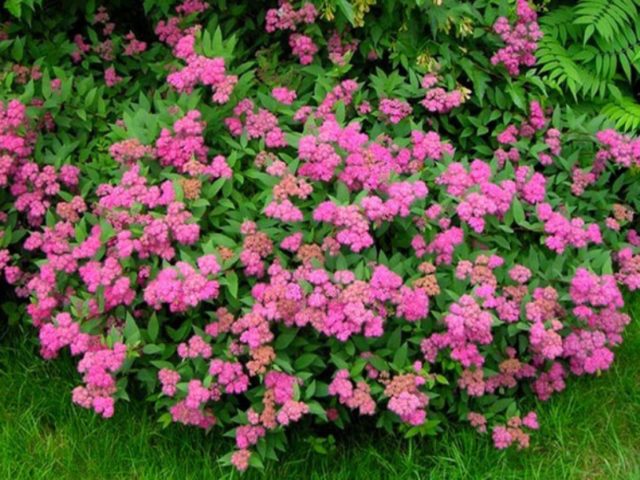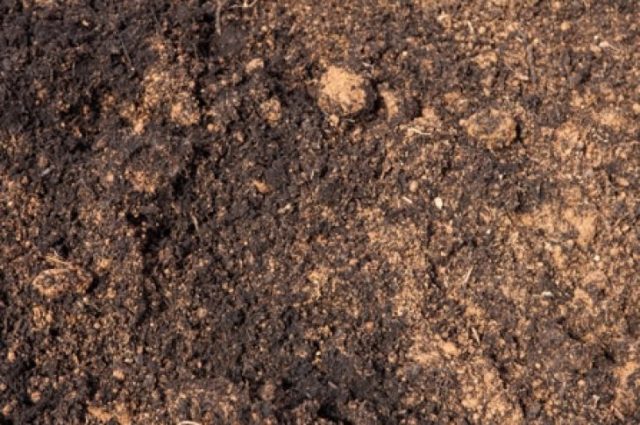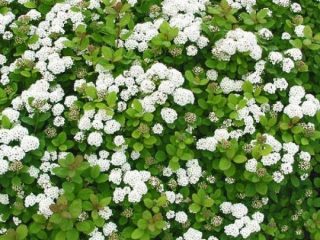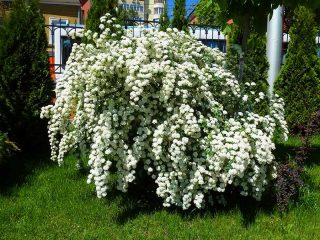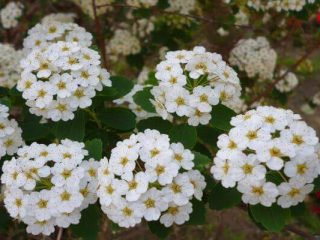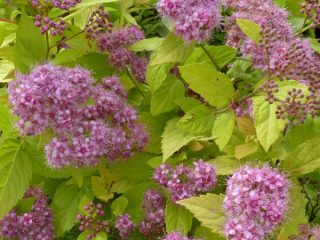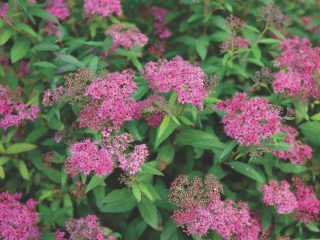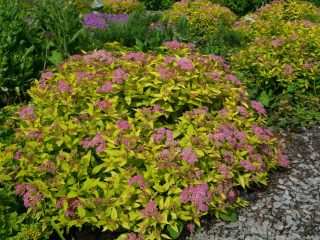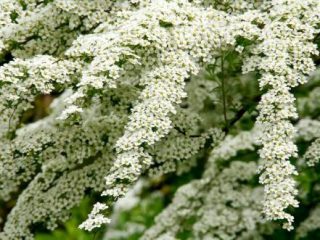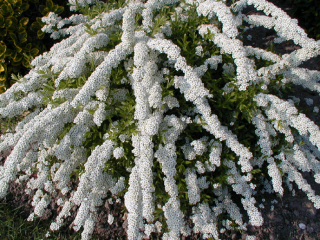Content
The short, lush shrub spirea Anthony Waterer is used for landscaping park areas and gardens. The bright green foliage and lush color of carmine inflorescences make spirea of this species a true decoration of the landscape. The shrub has become widespread not only because of its bright colors, but also because of its unpretentiousness.
Characteristic
The beauty of Anthony Waterer's spirea can be judged from the photo and without going into a detailed description. For the average person, it’s just a very beautiful bush, looking like a lilac from a distance. But each type of spirea has its own characteristics.
Japanese spirea is a compact spherical shrub. The height and diameter of the crown of the Anthony Waterer spirea does not exceed 80 cm. The shrub grows slowly and for a long time - no more than 5 cm per year.
The leaves of the plant are dark green, rich in color, pointed with serrations, and oblong in shape. In spring they can turn reddish, at the end of autumn - bright scarlet.
The flowers are small, bright pink or crimson, sometimes with a lilac tint. Many small flowers form a large inflorescence, about 15 cm in diameter. They densely cover the entire plant, forming a lush purple cap.
The Anthony Waterer spirea begins to bloom in early June. The bush fades at the end of September. The entire period is approximately 3 months.
The shrub grows well in illuminated meadows and in partial shade. The composition of the soil does not affect growth and flowering.
Spiraea of this species is unpretentious and tolerates winters and hot summers well. Resistant to pests and diseases.
The plant is used in landscape design to create decorative hedges. Spiraea is included in living flower arrangements and used as a fence in flower beds. Goes well with all types of coniferous plants.
Planting and caring for spirea Anthony Waterer
It is necessary to place Anthony's spirea in sunny, well-lit areas. Young plants are planted in warm autumn - in September. Before planting, the soil must be fertilized with peat and sand. This way the plant will take root faster, grow and give lush color.
Preparation of planting material
To transfer Antoni Waterern's spirea, a permanent place is chosen on a cloudy or rainy day in September. For planting, cuttings of plants that are well rooted or shoots with the same qualities are suitable. They are carefully removed from the soil, trying to preserve as much as possible all the branches of the root system. All broken and dried shoots must be carefully cut off. Seedlings with well-developed rhizomes are soaked for half an hour in a solution of a growth stimulator with water. Succinic acid is suitable for these purposes.
Rules for planting spirea Anthony Waterer
For planting, choose an area without groundwater. In the garden bed where the spirea will be placed, it is necessary to loosen and fertilize the soil.To do this, sand and peat are added to it. You can mix the soil with humus. Then dig a hole 50 cm deep. Its diameter should be 30% larger than the seedling’s earthen ball.
Drainage is placed at the bottom: expanded clay, broken brick, pebbles. The plant is placed in the center of the hole so that the root collar is at or above the soil level. The root must fit freely in the hole, all branches must be straightened.
The seedling is covered with loose soil mixed with peat and pitch in a ratio of 2:1:1, respectively. Then they trample her down. Then the plant is watered; a bucket of water will be enough. At the end of the work, the soil around the trunk is mulched, sprinkled with peat.
Watering and fertilizing
Spiraea Anthony Veterer needs watering in the first year after planting and during dry summers. During this period, the bush is watered 2 times a month. A bucket of water will be enough to moisten the soil. Before watering, loosen the soil to avoid stagnation of water. Afterwards, they mulch, sprinkling the moistened soil with a layer of peat or sawdust. This will prevent the soil from drying out.
In order for plants to grow and develop quickly, they are fed twice a year. In early spring, before the formation of buds, potassium, nitrogen, phosphate or complex fertilizers are applied to the soil. The procedure should be repeated in June.
Trimming
This is an important factor in the process of caring for Anthony Waterer's spirea. Timely pruning will avoid premature wilting of the plant and stimulate the formation of new flower stalks. Pruning of Antonio Vatteri's spirea is carried out in the fall after the bush has faded. You can do this in the spring before the buds begin to form.
Important steps and rules for pruning:
- Old woody branches are shortened to the level of growth of the first buds. Thin and dry branches must be completely removed.
- Spireas older than 5 years are pruned after the flowering period ends. For proper development, it is enough to leave the bush half a meter high.
- Spiraea Anthony Waterer older than 6 years is pruned after flowering. Only a small stump is left.
- For sufficiently formed bushes older than 3-4 years, the lower shoots are removed to form a thick, lush crown. It is also necessary to remove old woody branches to form young shoots.
In this way, you can extend the flowering time of the bush and promote the formation of new buds.
Preparing for winter
Japanese spirea Anthony Waterer tolerates temperature changes and Russian winters well. Only young growth and green shoots need shelter and protection. In late autumn, before frost sets in, they are covered with spruce forest, fallen leaves, and dried bark. In a later period, the bush can be covered with a layer of snow, under which the spirea will safely overwinter.
Diseases and pests
The main pest of Anthony Waterer's spirea is the spider mite. It is able to overwinter in the leaves of the bush, and in the spring begin to devour young greenery. At the same time, the foliage curls, turns yellow and falls off.
To combat this pest, various insecticidal preparations and agrotechnical methods are used, such as:
- timely pruning;
- regular removal weed;
- loosening and mulching the soil.
If you apply all control measures in combination, there will be no problems with the growth and flowering of the Anthony Waterer spirea.
Aphids are the second most common pest of any type of spirea. The peak of its invasion occurs in the summer months. This insect can completely destroy a bush in a matter of days. Leafworms and miners may also appear on spirea. The methods of dealing with them are similar: spraying with insecticides, loosening and mulching.
Anthony Waterer considers fungal infections to be the most common but rare disease of spirea. They occur due to improper care and stagnation of moisture in the soil.
Reproduction
Spiraea Anthony Waterer is a hybrid plant, so it does not propagate by seeds. It can only be rooted using cuttings and shoots.
They begin to harvest cuttings in mid-June, when the intensive growth of shoots ends. Thick, woody branches are cut off and divided into smaller ones, 10 cm each. Small branches are dipped at one end into a solution of water with a growth stimulator for 12 hours. Then they are rooted in a mixture of peat and sand (ratio 1:1). In order for the cuttings to take root quickly, frequent watering is necessary, at least once every 2 days.
In the spring, grown plants with formed rhizomes are transferred to a flowerbed and planted in a permanent place, following all the rules.
Spiraea Anthony Waterer can be propagated by shoots in the spring. To do this, choose strong young, well-developed layers. They are carefully bent and fixed approximately in the middle with metal brackets. This must be done so that the shoot is in contact with the soil. It is covered with fluffy soil along its entire length.
Watering is carried out regularly, about 2-3 times a month. For the winter, the plant is insulated with peat or fallen leaves.Next spring, the spirea will finally take root; it can be separated from the mother bush and moved to the right place.
Most spirea, including the hybrid Anthony Waterer, take root well and have a high survival rate. Therefore, propagating the mother plant will not be difficult. The main thing is to follow the rules of watering and protect young seedlings from winter frosts.
Reviews of spirea Anthony Waterer
Conclusion
A beautiful, unpretentious plant with beautiful and lush color is the Anthony Waterer spirea. It is quite common in our latitudes due to its frost resistance and good survival rate.In landscape design, it is used to create hedges and low borders. The shrub combines well with coniferous trees; it is used for staking tall plants.
